IOVI OPTIMO MAXIMO: to JUPITER, BEST and GREATEST
The Wheel-God · Jupiter Capitolinus · Capitoline Triad · Equestrian Jupiter · Jupiter Dolichenus
“Next to [Mercury] they worship Apollo, and Mars, and Jupiter, and Minerva; respecting these deities they have for the most part the same belief as other nations: [...] that Jupiter possesses the sovereignty of the heavenly powers [...].”
—Julius Cæsar (summarizing Posidonius)C. Ivlivs Caesar (summarizing Posidonius), De Bello gallico vi: 17. Translation based on W. A. McDevitte and W. S. Bohn (1869).
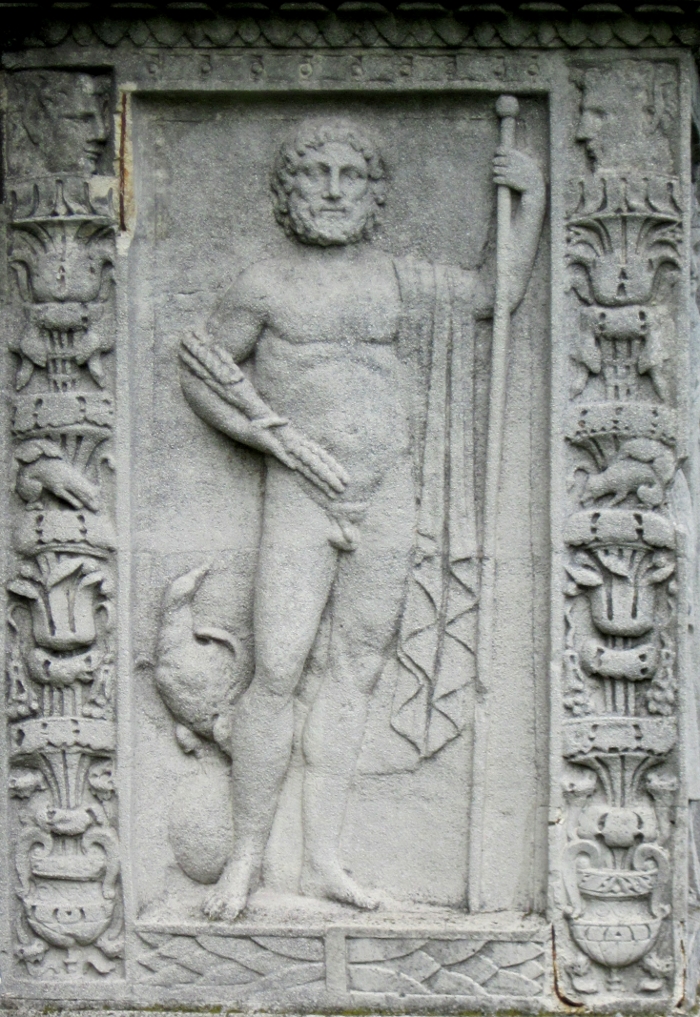
Depiction of Jupiter on the Mainz column. Note the god’s typical attributes: the thunderbolt, the sceptre, the eagle and the globe.
Not for nothing does Jupiter appear at the head of the Roman pantheon. King of heaven, final arbiter of destiny, universal father and creator, Jupiter also presents himself as the special protector and guarantor of Rome, both in its earthly empire and in its higher calling as a force for civilization. The State and the army were in accord on Jupiter’s supremacy. It is all the more remarkable for that reason that the Gauls’ preference for Mercury, which Posidonius already noted at the end of the second century bce, survived throughout the Roman pagan period.
The Jupiter whom Julius Cæsar declared to hold the sovereignty of heaven is shown bearded and holding in one hand a wheel which is thought to symbolize the sun, the sky or the cosmos. To this image of the god are joined the thunderbolt and eagle of the classical Jupiter, and at times a globe or a sceptre. In depictions and inscriptions, Jupiter is often accompanied by his formidable queen, Juno, and sometimes also by his excellent daughter Minerva. In eastern Gaul, a distinctive iconographic tradition depicts Jupiter on horseback, a thunderbolt in his hand, running to earth a serpent-legged giant. This image of Jupiter was normally placed atop a column on which other deities were also represented.
It’s worth mentioning that the word ‘Jupiter’ is irregular in Latin. While it does appear as Iúppiter in the nominative, the other cases use the root Ioui-, which gives Iouis in the genitive, Iouí in the dative, Iouem in the accusative, and Ioué in the ablative. The anglicization ‘Jove’, now used mainly in poetry and in the jocular exclamation ‘By Jove!’, thus has impeccable classical credentials. In epigraphic inscriptions, the most frequently encountered form is IOVI ‘to Jupiter’.
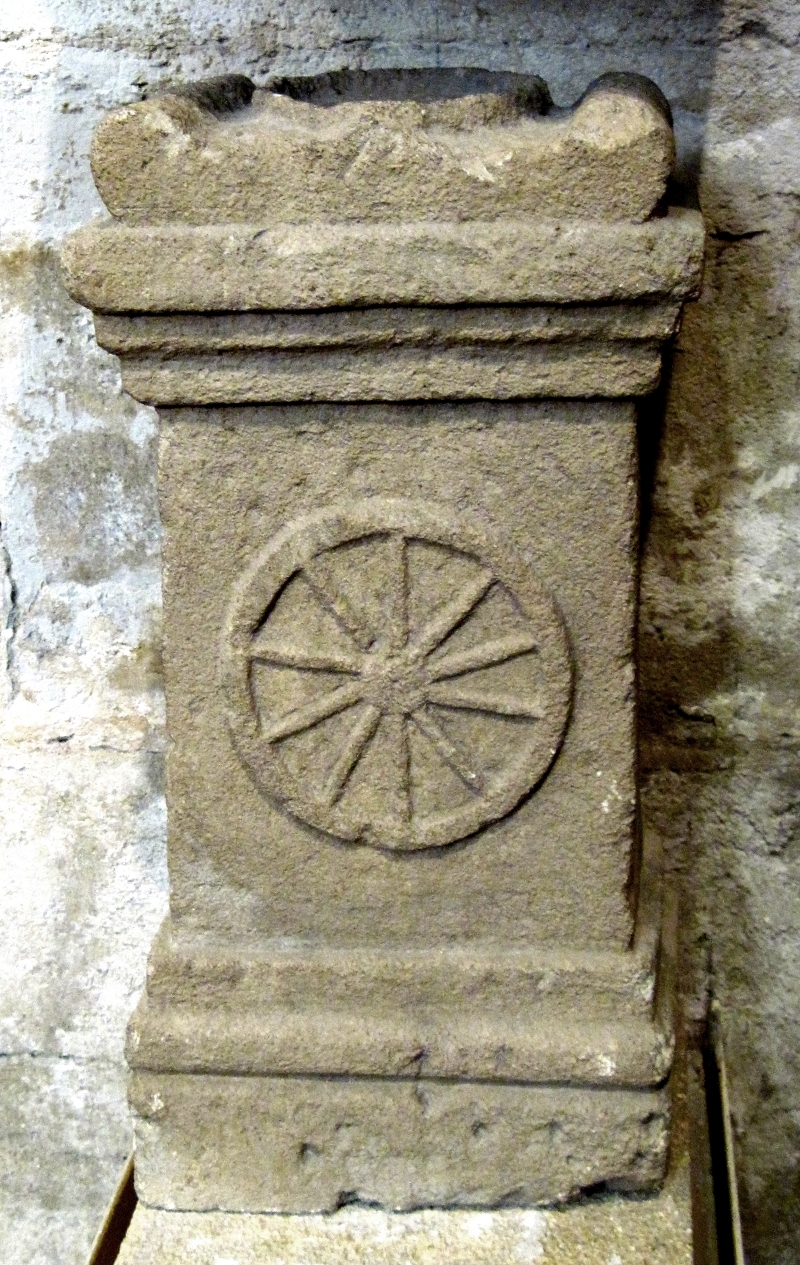
An altar to Jupiter appearing with no other decoration but the celestial wheel.
(Gallo-Roman, found at Codolet in the French department of the Gard and conserved at the Musée lapidaire d’Avignon)
The Wheel-God
In native iconography, Jupiter’s essential symbol is neither the thunderbolt nor the eagle, but the wheel. Often a bearded figure can be identified as this god solely on account of the wheel he holds in his hand. An altar need only depict a wheel to make it clear which god it honours. Little bronze wheel amulets have been found by the hundred in Celtic princely graves—a relic of prayers for the protection of the god of heaven, whether in this life or the next.
There are also depictions of Jupiter with the symbols of both the Gaulish and Roman sky-gods: the wheel and the eagle. This is the case of the high relief from Séguret, shown below (which also depicts a serpent—not an animal normally associated with the classical Jupiter). Depictions of the wheel-bearing Jupiter are concentrated in the southern parts of Gaul. They may represent an early stage of religious artistic expression, before Roman models had the chance to firmly take hold.
We should point out that, thanks to the importance that modern scholars have attributed to Lucan’s Pharsalia, it is now standard practice to call Jupiter ‘Taranis’ whenever he carries a wheel or is otherwise depicted in a Gaulish style. There is a sound basis to the identification of this name with the Gallic Jupiter, for the Celtic root taran- means ‘thunder’ (for example in Welsh and Old Breton). Other divine names related in etymology as well as meaning include Tonans ‘thundering’ (an epithet of the classical Jupiter) as well as Þórr (which is to say Thor, whom the ancient Germanic peoples identified with Jupiter; this is why we have the name ‘Thursday’ for dies Iouis, the ‘day of Thor/Jupiter’). However, Lucan does seem to have gotten the form of the Gaulish name wrong. The Orgon stone (found in the ancient territory of the Salluvii) is the only direct attestation of this name in Gaul. Its text, written in Gaulish in the Greek alphabet, runs as follows:
ΟΥΗΒΡΟΥΜΑΡΟС / ΔΕΔΕ ΤΑΡΑΝΟΟΥ / ΒΡΑΤΟΥ ΔΕΚΑΝΤΕΜBloc de pierre d’Orgon, L’encyclopédie de L’arbre celtique.
‘Vebrumaros gratefully dedicated a tithe to Taranus’
The word is Ταρανοου—equivalent to Taranou in Latin characters—whose dative ending -ou indicates a u-stem declension. The correct nominative form is thus Taranus.
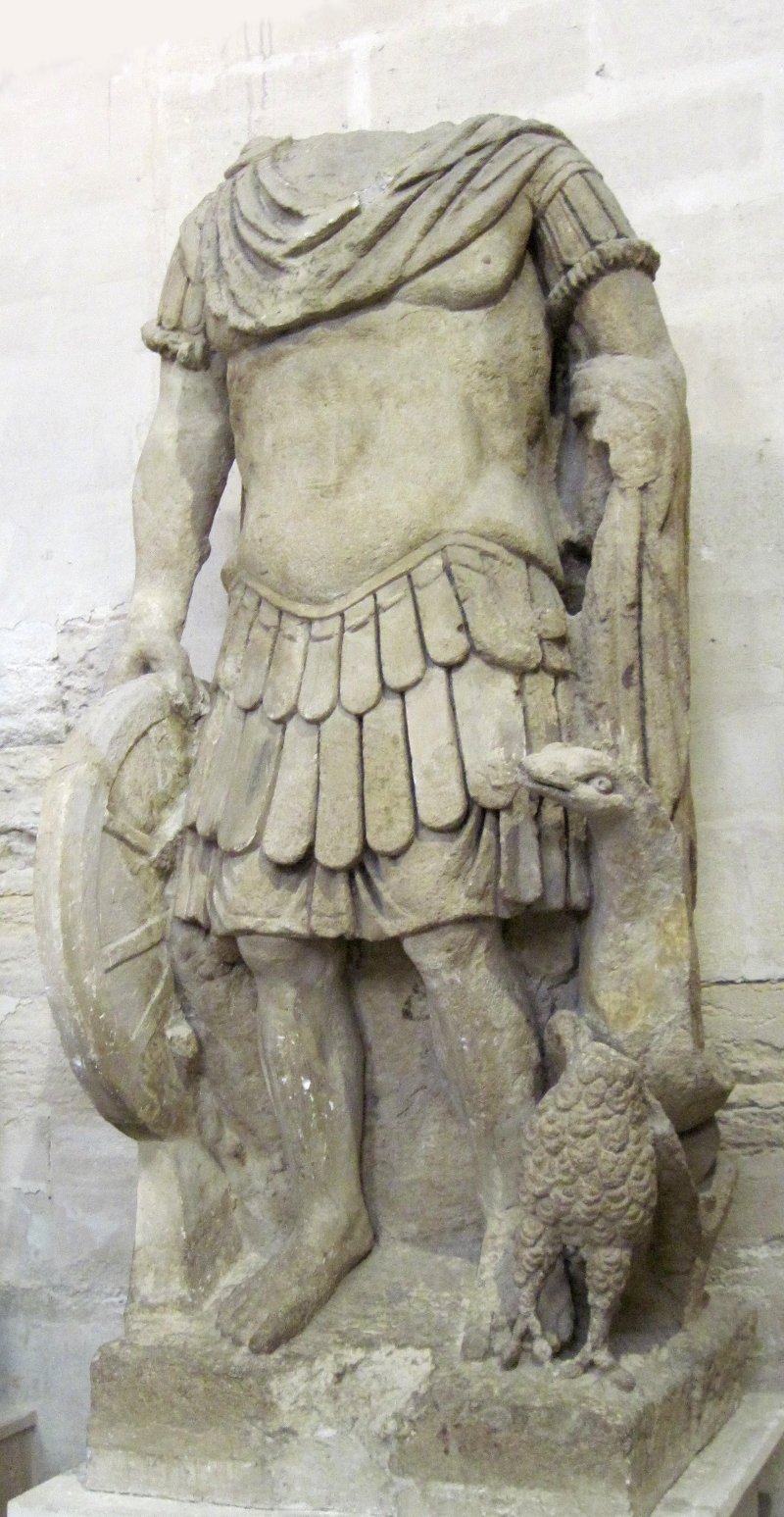
High relief of Jupiter in military uniform, flanked on the right by a wheel which he holds in his hand, and on the left by an eagle and serpent.
(Gallo-Roman, found at Séguret in the the Vaucluse and conserved at the Musée lapidaire d’Avignon)
Now, the name “Jupiter Taranis” (recte Taranus) is generally bandied about as though this formula were unremarkableness itself. Not so, however. Here are the only other inscriptions I can find relating to Taranus:
- Heilbronn (Germany): DEO TARANVCNO.Corpus Inscriptionum Latinarum (CIL) xiii: 6478. This is an altar decorated with a few swirls and sand-dollar motifs. This inscription shows that one Taranucnus (‘son of Taranus’) was worshipped as a god.
- Skradin/Scardona (Croatia): IOVI TA/RANVCO.CIL III: 2804. Now, here is an inscription linking the god Taranucnus—here found as Taranucus (-cos being an acceptable variant of the patronymic suffix -cnos)—with Jupiter. This piece of evidence comes from an area far from Gaul, but Celts had certainly reached Illyria by the 3rd century bce.
- Chester/Deva (England): I(ovi) O(ptimo) M(aximo) TANARO.CIL VII: 168. Now this is irrefutable: A dedicant in Great Britain has here identified Jupiter Best and Greatest to (drum roll) Tanarus. (This last is considered an archaic form of ‘Taranus’.)
- According to some scholars, this Celtic theonym is also attested in a Rhætic inscription from Tesero in the province of Trent, designated FI-1. The inscription is found on a carved antler (a typical Rhætic votive form) in the form Θarani, perhaps pronounced ‘Darani’, in the local Old Italic alphabet: 𐌔 𐌀[ / 𐌊𐌀𐌊𐌀𐌊𐌀[ / 𐌢𐌀𐌓𐌀𐌍𐌉[ / 𐌔𐌀𐌘𐌀𐌍𐌀 / 𐌢𐌀𐌓𐌀𐌍𐌉[. The interpretation of this text, written in a non-Celtic language related to Etruscan, is difficult. Θarani is thought to be one of only two theonyms thus far attested in Rhætic (the other being Tianu).Corinna Salomon (2007), Raetic: Language, Writing, Epigraphy, Prensas de la Universidad de Zaragoza, ISBN 978-84-16935-03-1, p. 17.
- ??Amiens/Samarobriva (France): TARANVOS.Année Épigraphique (AE) 1966: 269. The context—a graffito on the neck of a vase—makes it more likely that this was the name of the owner or maker of the vessel, rather than a religious dedication.
- ??Thauron (in the territory of the Lemovices, France): NVM(ini) AVG(usti) / ET I(ovi) O(ptimo) M(aximo) / TARANVEN[...] / D(e) S(uo) P(ro) P(ietate) P(osuit).AE 1961: 159. Here too, ‘Taranuen[...]’ ought to refer to the name of the dedicant; otherwise, his name is missing.
In sum, Taranus (rather than Taranis) was certainly worshipped in Gaul; he was linked with Jupiter, chiefly through the derivative Taranuc(n)us or in the archaic form Tanarus in Great Britain). Strictly speaking, however, the phrase ‘Jupiter Taranis’ is not authentic.
In the Pennine Alpes, there was a major cult to Jupiter Pœninus (this area lies just beyond the borders of Gaul). Meanwhile, in Hedderheim in Upper Germany, an altar decorated with a stylized thunderbolt was dedicated to Jupiter Olbius.CIL XIII: 7346.
Jupiter Capitolinus
While everybody knew the mythology that portrayed Jupiter as the lover of Ganymede, the abductor of Io and Europa and the errant father of Hercules, these were stoutly dismissed as the fantasies of poets. The Gauls nearly always worshipped Jupiter as the austere and magnificent god of the Capitol, a heavenly king accompanied, naturally enough, by his rightful queen. The distinctive name of Jupiter of the Capitol is Jupiter Best and Greatest (Iouí Optimó Maximó), a Latin formula so familiar that it is nearly always found in the abbreviated form I·O·M.
Jupiter is almost always depicted as a mature man—most often nude and muscular—with a flowing beard and hair. The thunderbolt that is his main attribute does not closely resemble the lightning bolts that one sees in nature. Instead, it is more of a rod or bat around which the static lightning bolts are rolled up.
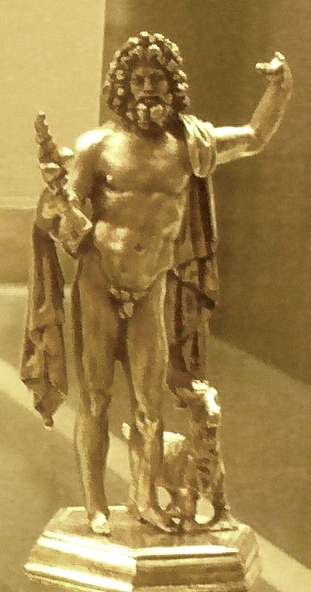
A silver statuette depicting Jupiter with a thunderbolt and sceptre (of which the latter has disappeared). The ram that accompanies him is unusual; it may have served to call to mind the close relationship between Jupiter and Mercury, the god with whom this animal is normally associated.
(Mâcon treasure, conserved at the British Museum)
Dedications to Jupiter Best and Greatest are found everywhere in Gaul. In the more militarized provinces of Germania Superior and Germania Inferior), they are more numerous than those to any other god. It is quite common in military circles for a dedication to invoke in one breath the honour of the divine house (in honórem domus díuínae, abbreviated IN·H·D·D), Jupiter, the goddess Fortune, the genius of the cohort and/or the genius loci, and sometimes “all the other immortal gods and goddesses”. The cult of Jupiter provided common ground for soldiers who might originate anywhere in the Empire. The most widespread literary works—chief among them Virgil’s Æneid—made known the special role that Jupiter had confided to Rome among all and sundry. Here, for example, is an extract from Jupiter’s famous speech to Venus:
“Daughter, dismiss thy fears; to thy desire
the fates of thine are fixed, and stand entire.
Thou shalt behold thy wished Lavinian walls;
and, ripe for heaven, when fate Aeneas calls,
then shalt thou bear him up, sublime, to me:
No councils have reversed my firm decree.
And, lest new fears disturb thy happy state,
know, I have searched the mystic rolls of Fate:
[...] Romulus his grandsire’s throne shall gain,
of martial towers the founder shall become,
the people Romans call, the city Rome.
To them no bounds of empire I assign,
nor term of years to their immortal line.
[... D]ire debate and impious war shall cease,
and the stern age be softened into peace:
Then banished Faith shall once again return,
and Vestal fires in hallowed temples burn;
and Remus with Quirinus shall sustain
the righteous laws, and fraud and force restrain.”P. Vergilivs Maro, Aeneidos i: 257-260, 275-279, 291-293. The translation is John Dryden’s (1697)—not a scholarly but a literary translation, and indeed a literary work of great merit in its own right. Here is the Latin original:Parce metu, Cytherea : manent immota tuorum
fata tibi ; cernes urbem et promissa Lauini
moenia, sublimemque feres ad sidera caeli
magnanimum Aenean ; neque me sententia uertit.
[...]
Inde lupae fuluo nutricis tegmine laetus
Romulus excipiet gentem, et Mauortia condet
moenia, Romanosque suo de nomine dicet.
His ego nec metas rerum nec tempora pono ;
imperium sine fine dedi. [...]
Aspera tum positis mitescent saecula bellis ;
cana Fides, et Vesta, Remo cum fratre Quirinus,
iura dabunt.
Jupiter’s temple on the Capitol was the most sacred and inviolable site in the Roman state; all that menaced it (fires, riots, civil war) caused no less collective trauma than an attack on the Golden Temple at Amritsar or the Dome of the Rock in Jerusalem. Even when the Celtic warlords Belenus and Brennus sacked Rome, the Capitol escaped them. The news of the destruction of this temple in 69 ce is said to have greatly encouraged the rebel forces of Civilis in Gaul, leading the druids to take this disaster as a sign that dominion of the world would pass to them.... At the same time, the man to whom the divine Vespasian entrusted the restoration of the Capitol was himself a Gaul—Lucius Vestinus, a Roman knight from Vienne (now in the French department of the Isère).Cornelivs Tacitvs, Historiae iv: 53-54.
The Capitoline Triad
At Jupiter’s side in the temple of the Capitol were Juno Regina and Minerva. All three are invoked together by name on a number of religious inscriptions in Gaul (particularly those from military zones, as in the Germanies).
Jupiter Conservator
It’s worth pointing out that in Gaul, Jupiter is invoked essentially in Latin, even on inscriptions where we find a Mars with a Celtic epithet or other native deities such as the Dii Casses. The crushing majority of dedications to Jupiter identify him as ‘Jupiter Best and Greatest’, in other words as the Capitoline Jupiter as we have seen. There are dedications to Jupiter Tonans ‘thundering’, Fulgur ‘lightning’, Auctor Bonarum Tempestatium ‘maker of good storms’, as well as to Jupiter Frugifer ‘fruit-bringing’, Conservator ‘the preserver’, and Depulsorius ‘averting evil’, among others.
After Jupiter Best and Greatest, the form of Jupiter most frequently mentioned in our inscriptions is Jupiter Conservator. In this role, Jupiter is tasked with the preservation of good order—with stability in heaven as well as on earth. This aspect took on a more personal significance for the emperor Domitian: he dedicated a temple to Jupiter Conservator at the site where he had been saved as a boy during the incendiary uprising of the year 69.Cornelivs Tacitvs, Historiae iii: 74.
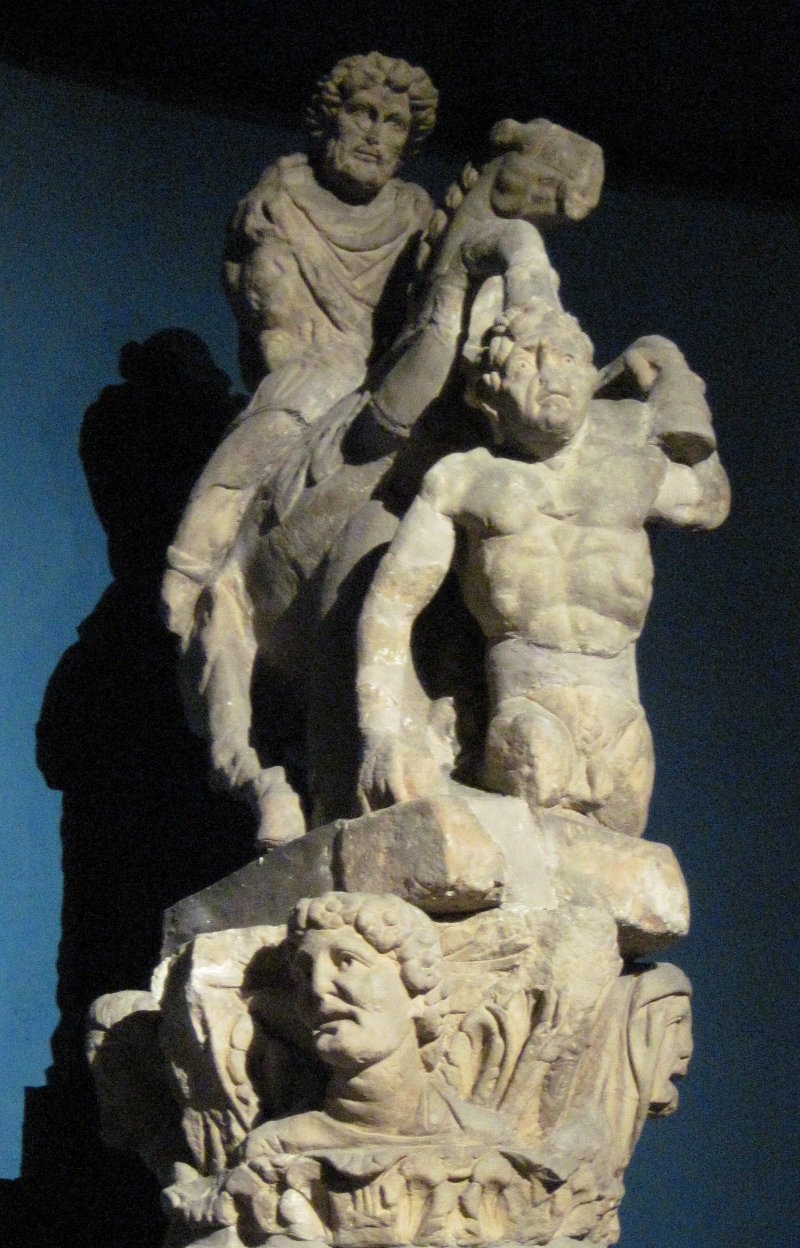
The upper part of the Merten column: an equestrian Jupiter rides down a serpent-legged giant (Typhon?). Below, the column’s capital features acanthus leaves (the normal motif in the Corinthian order) and representations of the four seasons.
(Musées de la Cour d’Or, Metz)

Complete reconstruction (in colour) of a Jupiter column at Schwarzenacker.
(Modification of a photograph by LoKiLeCh, CC BY-SA)
The Equestrian Jupiter
One of the most remarkable types of Gaulish religious monuments is the Jupiter–giant column, scores of which are to be found across Gaul and the Germanies, with an especial concentration in Gallia Belgica.
Such columns share many distinctive features. At the top, we find Jupiter with a thunderbolt (and sometimes with a wheel as well), mounted on a horse that is riding down a giant with thick serpents for legs. The latter motif recalls the Gigantomachy, the war between gods and giants, whose literary roots go back as far as Hesiod. This particular kind of depiction, however, is Gaulish. Jupiter is almost never found on horseback elsewhere; the Gigantomachy involves all the gods, not just Jupiter; and the idea of raising an equestrian Jupiter in single combat with a giant at the top of a pillar is entirely without precedent in the Mediterranean world. The giant in question might perhaps be identified as Typhœus, who sought to replace Jupiter as sovereign of heaven,Clavdianvs, Gigantomachia (unfinished work). or else Porphyrion whom Jupiter is known to have struck down with his thunderbolt,Pseudo-Apollodorvs, Bibliotheca I.vi.1–3. It was Hercules who delivered the coup de grâce to Porphyrion with his arrows. This might be the most notorious giant that Jupiter struck with his thunderbolt and Hercules finished off. if he does not stand in for all the giants implicated in the Gigantomachy. The symbolism, in any case, is reasonably clear: this is a celebration of the triumph of celestial order over chthonic chaos.Cf. the interpretation of Greg Woolf (“Representation as Cult: the case of the Jupiter columns”, in Wolfgang Spickermann et al. (eds., 2001): Religion in den germanischen Provinzen Roms. Mohr Siebeck, Tübingen, pp. 117ff.)
(One variation, typical of Germania Inferior, depicts Jupiter atop the column seated on a throne, rather than the equestrian motif with a giant that we have just described.)
Below the statue of Jupiter, the columns feature a Corinthian capital embellished with allegorical figures of the four seasons, followed by a shaft decorated with a pine cone motif. An octagonal pedestal can depict the seven planetary deities: Saturn, Sol, Luna, Mars, Mercury, Jupiter and Venus, (with the eighth face for the dedicatory inscription). The whole stands atop a four-sided plinth with low reliefs of one or two deities on each side, sometimes with a dedicatory inscription that dedicates the whole to Jupiter. Among the deities represented we frequently find Juno Regina, Minerva, Hercules, Apollo, Vulcan, and Fortuna, among others. The gods in question serve as a representation (neither exhaustive nor exclusive) of the pantheon; their presence assures the onlooker that all the gods participate in the cosmic order guaranteed by the power of Jupiter, each co-operating in harmony and unity with the others.
As a high monument at the centre of a sacred precinct, the Jupiter column probably takes the place of the sacred treeJean Mertens, “Interférences culturelles aux confins des provinces de la Germania Inferior et de la Belgica”, in Hélène Walter (ed., 2000), La sculpture d'époque romaine dans le nord et l'est des Gaules et dans les régions avoisinantes. Presses universitaires de Franche-Comté. that held a similar position of honour in the sanctuaries of pre-Roman Gaul. The pine cone motif may be a relic of this arboreal legacy, or else it may symbolize the long-lastingness of the Pax deorum.
Jupiter Dolichenus
Jupiter was present among the Gauls in other forms as well. The most distinctive, perhaps, is Jupiter of Doliche, a Syrian town (now in Turkey) from which a mystery cult was propagated. This cult enjoyed a certain vogue in the 2nd century ce, for example among the soldiers of Mainz.
Notes

En français svp !

Auf deutsch, bitte!
Viducus Brigantici filius dedicates this to the god Mercury and to the other immortal gods and goddesses in the year 2773 since the foundation of Rome (2020 of the Common Era).
